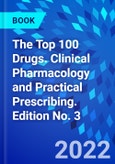Now in its third edition, this small and accessible guide contains essential information for the safe prescribing of the most commonly used drugs in the NHS.
The Top 100 Drugs combines the best elements of a students' textbook with those of a prescribers' manual. It gives equal weight to essential information on the science of pharmacology as well as the real-world practicalities of prescribing, all in an accessible and clear format.
Written by leaders in the field of clinical pharmacology, this popular book has been fully revised and updated to include the drugs used today, including monoclonal antibodies and antiviral drugs for COVID-19. With common indications, mechanism of action, adverse effects, important interactions and a clinical tip for each drug as well as questions to test knowledge, this book is key to helping students understand everything they need to know about the drugs they are likely to use in practice.
- Compact and easy to follow - can be carried around on the wards
- Logically ordered - offers multiple ways to find the drug you are looking for
- A Clinical Tip for each drug, drawn from the authors' experience
- 100 self-assessment questions to encourage integration and revision of knowledge and understanding
- Fully updated to include the most commonly prescribed drugs today, based on original research led by the authors of over 1 billion community prescriptions and approximately 1 million hospital prescriptions
- All drug monographs extensively reviewed and updated
- Dedicated section emergency drugs
- Updated self-assessment material, now including calculation and prescription-writing questions, in addition to single-best-answer questions
Table of Contents
List of abbreviationsIntroduction
The top 100 drugs listed
by system
The top 100 drugs listed
by indication
The top 100 drugs
(alphabetical listing)
5?-reductase inhibitors
?-blockers
Acetylcholinesterase inhibitors
Acetylcysteine (N-acetylcysteine)
Activated charcoal
Adenosine
Adrenaline (epinephrine)
Aldosterone antagonists
Alginates and antacids
Allopurinol
Aminoglycosides
Aminosalicylates
Amiodarone
Angiotensin-converting enzyme
(ACE) inhibitors
Angiotensin receptor blockers
Antidepressants, selective
serotonin reuptake inhibitors
Antidepressants, tricyclics
and related drugs
Antidepressants, venlafaxine
and mirtazapine
Antiemetics, dopamine
D2-receptor antagonists
Antiemetics, histamine
H1-receptor antagonists
Antiemetics, serotonin
5-HT3-receptor antagonists
Antifungal drugs
Antihistamines
(H1-receptor antagonists)
Antimotility drugs
Antimuscarinics, bronchodilators
Antimuscarinics, cardiovascular
and gastrointestinal uses
Antimuscarinics, genitourinary uses
Antipsychotics,
first-generation (typical)
Antipsychotics,
second-generation (atypical)
Antiviral drugs
Antiplatelet drugs, ADP-receptor antagonists
Antiplatelet drugs, aspirin
Azathioprine
?-blockers
?2-agonists
Benzodiazepines
Bisphosphonates
Calcium and vitamin D
Calcium channel blockers
Carbamazepine
Cephalosporins and
carbapenems
Chloramphenicol
Corticosteroids (glucocorticoids), inhaled
Corticosteroids (glucocorticoids), systemic
Corticosteroids (glucocorticoids),
topical
Digoxin
Dipeptidylpeptidase-4 inhibitors
Direct oral anticoagulants
Diuretics, loop
Diuretics, thiazide and
thiazide-like
Dopaminergic drugs for
Parkinson's disease
Emollients
Fibrinolytic drugs
Gabapentin and pregabalin
H2-receptor antagonists
Heparins and fondaparinux
Insulin
Iron
Lamotrigine
Laxatives, osmotic
Laxatives, stimulant
Leukotriene receptor antagonists
Levetiracetam
Lidocaine
Macrolides
Metformin
Methotrexate
Metronidazole
Naloxone
Nicotine replacement and
related drugs
Nitrates
Nitrofurantoin
Non-steroidal
antiinflammatory drugs
Ocular lubricants (artificial tears)
Oestrogens and progestogens
Opioids, strong
Opioids, weak/moderate
Oxygen
Paracetamol
Penicillins
Penicillins, antipseudomonal
Penicillins, broad-spectrum
Penicillins, penicillinase-resistant
Phosphodiesterase (type 5)
inhibitors
Prostaglandin analogue eye
drops
Proton pump inhibitors
Quinine
Quinolones
Serotonin 5-HT1-receptor
agonists
Sex hormone antagonists for
breast cancer
Statins
Sulphonylureas
Tetracyclines
Thyroid hormones
Trimethoprim
Valproate (valproic acid)
Vancomycin
Vitamins
Warfarin
Z-drugs
Fluids
Colloids (plasma substitutes)
Compound sodium lactate
(Hartmann's solution)
Glucose (dextrose)
Potassium chloride
Sodium chloride
Self-assessment and knowledge integration
100 single best-answer questions
Answers and explanations
Index
Authors
Andrew W. Hitchings Reader in Clinical Pharmacology, St George's, University of London, Honorary Consultant in Neurointensive Care, St George's University Hospitals NHS Foundation Trust, London.Dagan Lonsdale Honorary Senior Lecturer, St George's, University of London; Specialty Registrar in Clinical Pharmacology, General Medicine and Intensive Care Medicine, St George's University Hospitals NHS Foundation Trust, London, UK.
Dagan Lonsdale, BSc(Hons) MBBS MRCP FHEA, Honorary Senior Lecturer, St George's, University of London; Specialty Registrar in Clinical Pharmacology, General Medicine and Intensive Care Medicine, St George's University Hospitals NHS Foundation Trust, London, UK
Daniel Burrage NIHR Doctoral Research Fellow, St George's, University of London; Specialty Registrar in Clinical Pharmacology, General Medicine and Stroke Medicine, St George's University Hospitals NHS Foundation Trust, London, UK.
Daniel Burrage, BSc(Hons) MBBS MSc (Med Ed) MRCP FHEA , NIHR Doctoral Research Fellow, St George's, University of London; Specialty Registrar in Clinical Pharmacology, General Medicine and Stroke Medicine, St George's University Hospitals NHS Foundation Trust, London, UK
Emma Baker Professor of Clinical Pharmacology, St George's University of London; Honorary Consultant Physician, St George's University Hospitals NHS Foundation Trust, London, UK..
Professor Emma Baker (PhD FRCP) is a clinical academic with roles in research, teaching and clinical medicine. At St George's, University of London she is the head of the Clinical Pharmacology Unit, lead for prescribing education and assessment and chair of the Drugs and Therapeutics Committee. Current external roles include respiratory specialty group lead, (London South Comprehensive Local Research Network) and executive editor of the British Journal of Clinical Pharmacology.
In research, she gained her PhD from Manchester University in 1996. She subsequently moved to St George's and developed a research programme in epithelial transport and respiratory infection, with external funding from bodies including the Wellcome Trust and Medical Research Council. Her research has developed from early work in molecular biology to development and implementation of investigator-led clinical trials.
In teaching, she was awarded a National Teaching Fellowship of the Higher Education Academy in 2003 and has received a St George's undergraduate teaching prize in eight different years. She has co-authored a respiratory text book (Case-based respiratory medicine) and is currently leading her clinical pharmacology trainees in writing two new prescribing textbooks for publication in 2014.
In clinical practice, she has a specialist interest in chronic obstructive pulmonary disease and runs an outpatient service for patients with airways disease. She shares the inpatient care of respiratory patients with four colleagues and is on the on call rota for acute medical intaking.








